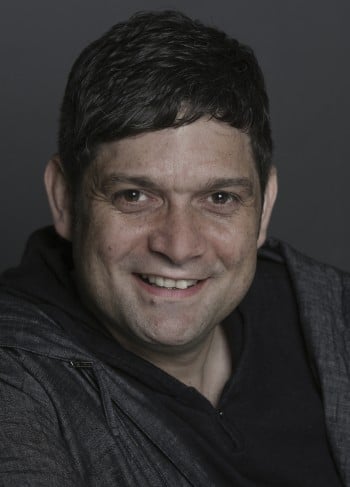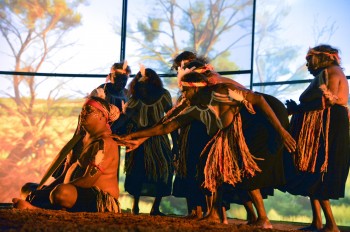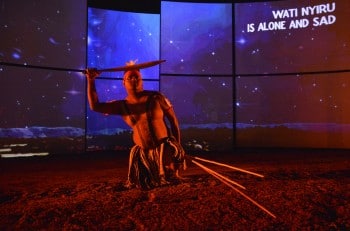Celebrating Canberra’s Centenary: Kungkarangkalpa Seven Sisters Songline
Aussie Theatre’s Dione Joseph recently spoke with Stradbroke Island man Wesley Enoch – Artistic Director of Kungkarangkalpa: Seven Sisters Songline which was performed by Central Desert dancers early this month as part of Canberra’s Centenary celebrations.

Wesley Enoch is a man who loves to work hard. And he thrives upon it. But despite a ridiculously busy schedule as Queensland Theatre Company’s Artistic Director and working upon a number of different projects, Enoch always makes time to have a conversation about his work.
Recently we discussed the Kungkarangkalpa: Seven Sisters Songline project which saw senior dancers from the Central Desert bring the ancient song cycle to Lake Burnley Griffin. In an active performance of singing up the land these four performances formed part of the centenary celebrations in Canberra.
The history of the project is as fascinating as the massive scale upon which it is being undertaken. Unknown to many, this desire to showcase the spiritual and artistic richness of the nation in a new way began more than twelve years ago.
“It goes back to the Sydney 2000 Olympics,” explains Enoch, “When we realized that we wanted something more from the Indigenous component of the ceremonies; we wanted stories and performances that are reflective of who we are today as Indigenous people of Australia.”
Over ten years Enoch has been having conversations, not only with numerous different people from all over the country (including Robyn Archer, Creative Director of the Centenary of Canberra), but also spending quality time in the Central Desert.
“The Seven Sister’s songline runs from the tip of Canberra all the way to WA and I’ve been to five gatherings to be with the singers and dancers, as we remembered the songlines and, in some cases, we also had to re-imagine the songlines.”
The performances reflected upon the familiar story of the Seven Sisters, a legend that is trans-cultural and has numerous different versions across the globe. However, the central theme remains the same: “man pursuing woman … lust destroying love” (taken from the Kungkarangkalpa: Seven Sisters Songline website). This version though perhaps one of the most technologically orientated performances, brings together traditional elements and sophisticated elements of modern production to create a completely new setting.

“The heightened nature of the story implies that the term operatic is quite suitable to describe the traditions and cultural ceremonial purpose of the dance,” explains Enoch, “To do this we needed technology. Not only to preserve the magic of telling this story physically within this particular time and space but also to share it with the community and especially the family members out on country. They gathered in front of a large projection screen to watch this moment unfold as if they were right there, participating in the ceremony.”
Apart from the live streaming, the projectors themselves (which may have appeared to dominate) were in fact a deliberate set piece because they provided a context for the story.
“There are moments when performers can’t be on screen,” explained Enoch, “but their presence needs to be felt and we accomplished that by being able to project shadows. That was the magic of being able to create ‘presence’ and also through the presence of technology we in turn could affirm the magic of this story.”
With only four showings in Canberra (luckily the Saturday night performance was available as a live webcast) it may seem like a tremendous amount of work for a very limited product output. But this is only the first step.
“The process of making this particular part of Seven Sisters is that it is only one segment of what will become a suite of things; including an exhibition, art and cultural material, and potentially a ceremonial outcome.” And of course there is the very feasible option that it will be made into either a play or performance under the stewardship of QTC.

Enoch’s production highlights new ways that are currently being developed to create hybridized forms of presenting Indigenous stories to a new generation of Australians.
“We are at a very exciting time in our history, new definitions of Indigenous theatre are being explored relationships are being developed,” says Enoch. “Yet one of the crucial concerns is that for the majority of projects Indigenous control is still restricted to the fringes; as a result of which many Indigenous artists are still living a subsistent life-style in regards to their art form. Of course there are exceptions but we need to explore the context, the infrastructure and the complexity of ideas that really shape what Indigenous theatre can mean in our world today.”
The Seven Sisters project is one example where the discussion of what exactly is our “cultural capital” can be more fully explored, and in doing so, being aware of the changes that are taking place.
“The Australian landscape has an unprecedented effect on our people. As the external environment is changing so too is our psyche and right now we are witness to a diversity of ideas that are gradually being developed, and this reflects how increasingly articulate we are as artists and as an artistic community.”
Indigenous theatre is changing and right now, as we watch a range of different projects take a place on our local and national stages, we are in a privileged position to witness those changes, in all their myriad of forms.
